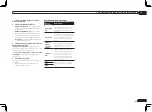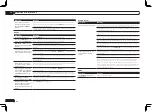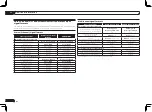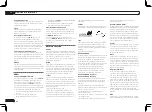
En
77
13
Additional information
Symptom
Remedy
No sound from surround back
speakers.
Check that the surround back speakers are set to
LARGE
or
SMALL
, and the
surround speakers are not set to
NO
(see
Speaker Setting
on page 69 ).
Check the speaker connections (see
Connecting the speakers
on page 13 ). If
only one surround back speaker is connected, make sure it’s connected to the
left channel speaker terminal.
Surround back speakers will not play while the
Speaker System
is set to
Speaker B
and audio is being played through speaker B.
When
Speaker System
is set to
Normal(SB/FH)
or
Normal(SB/FW)
and
SP:
FH ON
or
SP:
FW ON
is selected with the
SPEAKERS
button, no sound will be
output from the surround back speakers. Select
SP:
SB/FH ON
,
SP:
SB/FW ON
or
SP:
SB ON
(see
Switching the speaker terminals
on page 53 ).
No sound from front height or
front wide speakers.
Check that the front height or front wide speakers are set to
LARGE
or
SMALL
,
and the surround speakers are not set to
NO
(see
Speaker Setting
on page 69 ).
When
Speaker System
is set to
Normal(SB/FH)
or
Normal(SB/FW)
and
SP:
SB ON
is selected with the
SPEAKERS
button, no sound will be output from
the front height or front wide speakers. Select
SP:
SB/FH ON
,
SP:
SB/FW ON
,
SP:
FH ON
or
SP:
FW ON
(see
Switching the speaker terminals
on page 53 ).
Check the speaker connections (see
Connecting the speakers
on page 13 ).
No sound from subwoofer.
Check that the subwoofer is connected properly, switched on and the volume
turned up.
If your subwoofer has a sleep function, make sure it is switched off.
Make sure that the Subwoofer setting is
YES
or
PLUS
(see
Speaker Setting
on
page 69 ).
The crossover frequency may be set too low; try setting it higher to match the
characteristics of your other speakers (see
Speaker Setting
on page 69 ).
If there is very little low frequency information in the source material, change
your speaker settings to Front:
SMALL
/ Subwoofer:
YES
, or Front:
LARGE
/
Subwoofer:
PLUS
(see
Speaker Setting
on page 69 ).
Check that the
LFE
channel is not set to
OFF
, or to a very quiet setting (see
Setting the Audio options
on page 50 ).
Check the speaker level settings (see
Channel Level
on page 70 ).
No sound from one speaker.
Check the speaker connection (see
Connecting the speakers
on page 13 ).
Check the speaker level settings (see
Channel Level
on page 70 ).
Check that the speaker hasn’t been set to
NO
(see
Speaker Setting
on page
69 ).
The channel may not be recorded in the source. By using one of the advanced
effect listening modes, you may be able to create the missing channel (see
Enjoying various types of playback using the listening modes
on page 37 ).
Symptom
Remedy
Sound is produced from
analog components, but not
from digital ones (DVD, LD,
CD, etc.).
Check that the input signal type is set to
DIGITAL
(see
Choosing the input
signal
on page 39 ).
Make sure that the digital input is assigned correctly for the input jack the
component is connected to (see
The Input Setup menu
on page 28 ).
Check the digital output settings on the source component.
If the source component has a digital volume control, make sure this is not
turned down.
No sound is output or a noise
is output when Dolby Digital/
DTS software is played back.
Check that your BD or DVD player is compatible with Dolby Digital/DTS discs.
Check the digital output settings or the HDMI audio output settings of your BD
or DVD player. Make sure that the DTS signal output is set to On.
If the source component has a digital volume control, make sure this is not
turned down.
No sound when using the
Home Menu
.
If the HDMI input function is selected, sound is muted until exiting the
Home Menu
.
Other audio problems
Symptom
Remedy
Speaker switching sound
(clicking sound) is heard from
receiver during playback.
Depending on the listening mode, the front height (or front wide) and sur-
round back speakers may switch automatically in function of changes in the
input audio. A speaker switching sound (clicking sound) will be heard from
the receiver at this time. If this sound bothers you, we recommend to change
the speaker terminal option (see
Switching the speaker terminals
on page 53 ).
Broadcast stations cannot
be selected automatically, or
there is considerable noise in
radio broadcasts.
Fully extend the FM wire antenna, adjust the position for best reception and
secure to a wall, etc.
Use an outdoor antenna for better reception (see page 21).
Adjust the position and direction of the AM antenna.
Noise may be caused by interference from other equipment, such as a fluo-
rescent light, motor, etc. Switch off or move the other equipment, or move the
AM antenna.
Noise is output when scanning
a DTS CD.
This is not a malfunction of the receiver. The scan function of your player
alters the digital information, making it unreadable, resulting in noise being
output. Lower the volume when scanning.
When playing a DTS format LD
there is audible noise on the
soundtrack.
Make sure that the input signal type is set to
DIGITAL
(see
Choosing the input
signal
on page 39 ).
Can’t record audio.
You can only make a digital recording from a digital source, and an analog
recording from an analog source.
For digital sources, make sure that what you’re recording isn’t copy protected.
Subwoofer output is very low.
To route more signal to the subwoofer, set it to
PLUS
or set the front speakers
to
SMALL
(see
Speaker Setting
on page 69 ).
Содержание VSX-1126-K
Страница 100: ...100 13 Additional information En ...
Страница 101: ...101 13 Additional information En ...
Страница 102: ...102 13 Additional information En ...
















































